From the Dean's Desk -- September 6, 2012
From the Front Lines of War to the Use of Forensics in the Battle for Justice
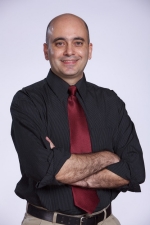
Maher "Max" Noureddine, class of 1993
In 1990, civil war was raging in Lebanon and Maher “Max” Noureddine was trying to cope with the danger and devastation around him. “You see, I was enrolled at the American University of Beirut, Lebanon at the time when the civil war in that country was intensifying by the day. My education and entire future were in limbo,” he says. That’s when he knew he had to find a more stable environment, just like many Lebanese of that time.
He applied to several colleges in the United States hoping to find a welcoming home away from home to pursue his dreams. In the summer of 1990, he received two acceptance letters – one from North Texas University and the other from RU. He was drawn to the natural beauty of the Blue Ridge Mountains. Plus, he heard his cousin Rola rave about her experiences as a student at RU. Choosing Radford changed his life in many ways.
Just prior to graduation, Noureddine completed his first set of experiments at RU that resulted in co-authorship in a well-respected journal. “I was hooked. The work involved spiders and their mating habits. People usually think that spiders build webs to catch insects, which is very true. Spiders are brilliant in many other ways. They "pluck" their webs, turning them into a complex string instrument that can propagate information to mates and enemies. Dr. Fred Singer was the Principal Investigator on the project. We called him ‘spider man.’ He was and still is an inspiration. Dr. Judy Niehaus was another excellent teacher and a big inspiration to me. Her course in non-vascular plants was my favorite. It taught me many skills, including the identification of edible mushrooms, something that I continue to practice today,” he adds.
After graduation in 1993, Noureddine took a year to work prior to completing a Master of Science degree program in molecular biology at UNC-Greensboro and then a Ph.D. in molecular genetics at UNC-Chapel Hill. He then began researching neurodegenerative disease at Duke University Medical Center as a fellow. His research focused on understanding the links between genetic factors and disease risk. He then joined the National Institute of Health in Research Triangle Park, N.C., to study cancer risk and environmental factors.
Next, he served as Chief Scientific Officer at Though Leader Select, LLC. And in 2010, he created an educational nonprofit organization called the Institute for Advanced Career Development (IACD). He and his institute are meeting the need for educational scientific resources for the community. “I think we all agree that forensic DNA evidence has revolutionized criminal investigations. Yet, there are many educational gaps that exist in that field, gaps that impact the real moving parts of our justice system, from jury, to judges, to attorneys on the prosecution and defense sides. The public opinion and psyche have been impacted by the ‘CSI Effect’. Although reliable under many circumstances, forensic DNA evidence has many limitations that must be respected and understood,” says Noureddine.
In early 2011, he began a consulting company called ForensiGen in Hillsborough, N.C., to continue his consulting work on criminal and civil cases in the hope of making a positive impact on this field. His company also conducts research including a project at the historic Harper House in Bentonville, N.C. Harper House served as the Union army’s XIV Corps hospital during the three-day battle of Bentonville. Noureddine is analyzing wood from the floors to analyze the content of suspected blood stains.
Next month, Noureddine will be visiting the college as a member of the CSAT Alumni Advisory Council.
Learn more about his work and contributions to the field of forensics.
Sigmon Publishes Textbook Born From Cryptology Honors Class
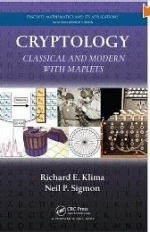
Math faculty member Neil Sigmon’s textbook Cryptology Classical and Modern with Maplets was published by CRC Press in June to meet the need for a specific cryptology textbook that incorporates Maplet technology.
Sigmon and Appalachian State math faculty member Rick Klima, the co-author of the text, chose to write the textbook because there wasn’t one in existence that met the needs of the RU Honors Academy cryptology course that Sigmon has taught for several years.
The textbook is designed to give an introduction to cryptology for students with less mathematical training. Topics of coverage include classical ciphers such as substitution, transposition, the Enigma cipher which is a verbal simulation of the Navajo code, and other more modern ciphers. Easy to use technology requiring no background programming knowledge using Maplets is integrated into each topic.
“We haven’t seen any other cryptography textbooks that integrate the easy to use Maplet technology like ours does, and we hope that is something that will make our textbook unique,” says Sigmon.
Sheehy Receives the MERLOT House Cup
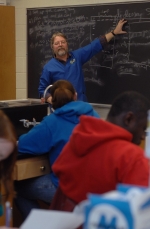
Biology professor Bob Sheehy was recently honored with the MERLOT House Cup. This award recognizes the level of contributions made to the MERLOT collection during an academic year. MERLOT, which stands for Multimedia Education Resource for Learning and Online Teaching, is an international initiative enabling faculty to integrate technology into higher education.
This year, the award was given to the organization’s biology editorial board of which Sheehy is a member. The MERLOT House Cup is a perpetual award that is passed to new winners at the MERLOT/Sloan-C Emerging Technologies Conference each year. The editorial board members will take turns displaying the award in their offices throughout the year.
Faculty Analyze Human Remains Found Underneath Mall Parking Lot
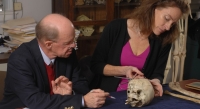
Anthropological science professors and co-directors of RU's Forensic Science Institute Cliff and Donna Boyd were recently called to the Old Cloverleaf Mall in Midlothian, Chesterfield County, Virginia. Construction crews were excavating the parking lot and found human bones and artifacts. "The parking lot had apparently been placed over an old, unmarked (probably family) cemetery dating to the 19th century," says Cliff Boyd.
A cultural resource management firm was hired to remove the small cemetery. It asked the Boyds to assist in the recovery and analysis of the remains. In all, six burials were identified, excavated and removed so construction could proceed. The team found buttons, and coffin remnants such as wood, coffin handles, hinges and nails -- in addition to the skeletal remains of six individuals. All artifacts were photographed and mapped in place before removal.
The Boyds and their undergraduate student assistants will analyze the human skeletal remains to determine their age, sex, ancestry and stature. They will also look for any evidence of diseases and assess the individuals' overall health. The remains will be reburied in a modern cemetery after the analysis is complete.
"We often have students helping us with this work -- it is great
training in skeletal analysis for them to actually look at, measure and
study bones from a site like this. We will probably be working on this
through the fall semester," says Cliff Boyd.
Physics Professor and Radford City Schools Partner to Solve Tennis Court Mystery
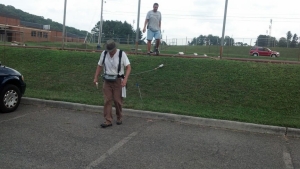
Physics professor Rhett Herman uses an Ohmmapper resistivity array to see below the surface of the tennis courts.
This summer, physics professor Rhett Herman partnered with Radford City Schools and Radford High School maintenance team to analyze the subsurface of the high school's tennis courts to figure out why the courts were warping and cracking. "The conditions of the courts are causing injuries and something needs to be done," says Herman.
Herman offered his time and expertise to conduct a geophysical survey with an OhmMapper resistivity array. This survey will help determine whether the existing tennis courts just need to be resurfaced, torn up and replaced in the current location, or constructed in a new location if there are geological problems with the current location.
"I told them that I'm not qualified to make a final interpretation, but that I could get them the data to give to the Radford City engineer to make that call. I offered to help the high school because my children attended the school and I live in Radford City," adds Herman.
CSAT STEM Club News
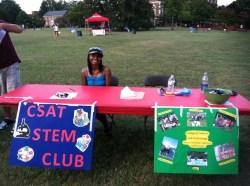
CSAT STEM Club secretary Jasmine Jackson "mans" the club's table during Club Fair on campus.
The CSAT STEM Club will be having its first meeting on Thursday, September 6 at 7 p.m. in the Stuart Hall Lounge. Dr. Orion Rogers, Dean of the College of Science and Technology, will be speaking at the meeting, and the club will provide pizza.
This semester we have many activities planned. First, the Fall Picnic is scheduled for Friday, September 28 at Bisset Park from 4 -7 p.m. The club will also visit either the Cascades or Dragon’s Tooth this year and a Pumpkin Patch sometime in October.
The club will continue to host faculty guest speakers this semester and will participate in the Highlanders Festival on October 13. More activities will be discussed at the meeting on Thursday. The club welcomes any ideas that you may have to make our club better.
Jasmine Jackson
CSAT STEM Club Secretary